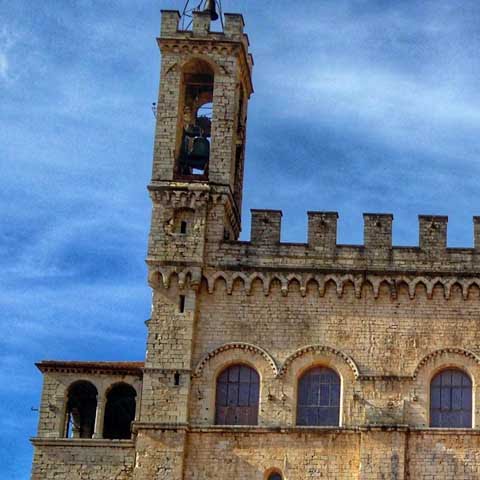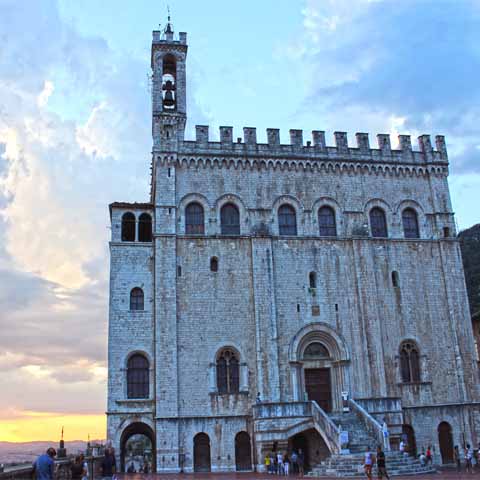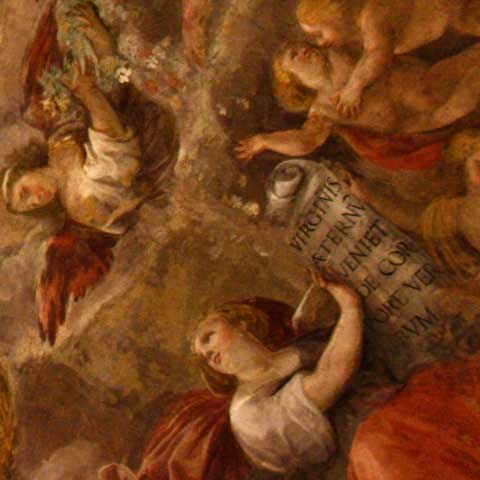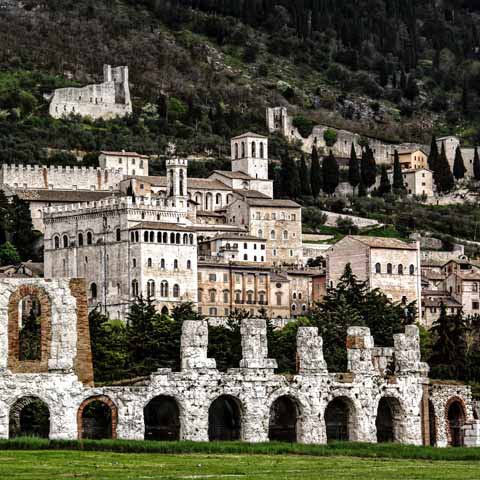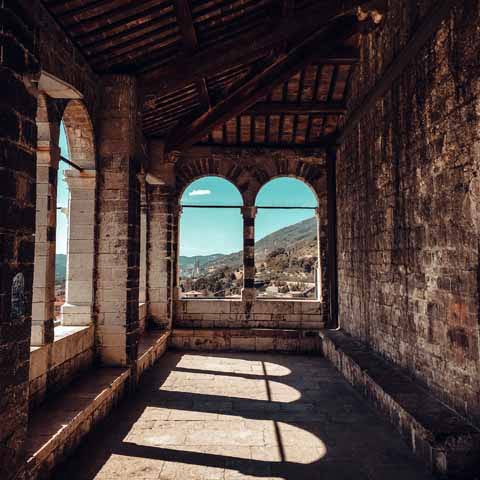Located northeast of Perugia and north of Assisi, the picturesque town of Gubbio extends over the foothills of Mount Ingino. As a result, the town is surrounded by remarkable views of the verdant countryside that is characteristic of the Umbria region. The imposing defensive walls date back to the Middle Ages, and the center of Gubbio features countless other examples of medieval architecture.
Gubbio is synonymous with the Eugubine Tablets, which contain the only surviving record of the Umbrian language. The town has also been a highly revered center of ceramic artwork for centuries. The Corsa dei Ceri is Gubbio’s most famous annual event and is considered to be one of the most evocative religious celebrations in Italy. Nowadays, Gubbio offers the perfect respite from fast-paced daily life with plenty of culture and history to discover all surrounded by tranquil scenery.
PREHISTORY OF GUBBIO
The first forms of settlement in the territory of Gubbio (Iguvium or Eugubium in Latin) date back to the Paleolithic Period. Additionally, remains of a Neolithic village have been found in the surrounding area.
In the Bronze Age, a settlement developed for several centuries on the overhanging Mount Ingino, and tombs dating back to the Bronze Age are evidence of this.
It is clear that Gubbio became an important center for the Umbrians. This is demonstrated by the Eugubine Tablets, dating back to between the third and first centuries BC, which are the most remarkable epigraphic heirloom of pre-Roman Italy. The tablets constitute the largest surviving text in the Umbrian language.
Rome conquered Gubbio during the second century BC and erected a municipium. As a municipality, the town flourished in the early centuries of the Empire, as demonstrated by the archaeological finds and remains, along with the Roman Theater.
HISTORY OF GUBBIO
With the decline of the Roman Empire, the Umbria region was crossed and devastated by the barbarian hordes that descended upon the peninsula. Subsequently, in the sixth century AD, Gubbio was the scene of bloody clashes between the army of Byzantium, which aimed to the reconquer the entire peninsula, and that of the Ostrogoths, led by Totila. In 552, the Goths were defeated by Byzantium, and Gubbio passed under the Byzantines.
Gubbio was occupied by the Lombard kings during the following two centuries. The Lombard Duchy of Spoleto was established in 571, encapsulated in a predominantly Byzantine Italy.
With the donations of Pepin the Short and Charlemagne, the Umbrian-Byzantine territories and the Duchy of Spoleto became part of the possessions of the Church.
During the Middle Ages, Gubbio became a populous and flourishing commune.
Despite internal struggles and participation in the wars between the Papacy and the Holy Roman Empire, Gubbio managed to extend its jurisdiction over a vast territory and to maintain considerable autonomy. Like many cities in Italy, Gubbio also sided with the Emperor then with the Pope, in a completely instrumental way, according to the personal interests of the ruling families.
Between the end of the eleventh century and the beginning of the twelfth century, powerful municipalities were formed in Umbria. The main ones included Perugia, Assisi, Spoleto, Terni, Foligno, Todi, Orvieto, Gubbio, and Città di Castello.
The creation of new administrative autonomies did not only concern the largest and most populous cities, but also the smaller centers. Umbria was fragmented into many municipalities, which competed for economic and artistic vitality, yet were united by a single strong spiritual current generated by religious movements.
During the eleventh century, Gubbio passed from the authority of the bishop to a state of self-government. Both Barbarossa in 1163 and Henry VI in 1191 guaranteed wide-ranging jurisdiction and privileges to Gubbio’s consuls. This fact resulted in strong hostility from neighboring Perugia.
In 1151, Perugia led an attack against Gubbio in an attempt to destroy it. The city defended itself and the following counterattack led to a crushing victory for Gubbio. The victory was attributed to the intervention of St. Ubaldo (1080-1160), then bishop of the city.
The increasing military and commercial power of Gubbio led to other clashes with Perugia until in 1257 when the Perugians occupied part of Gubbio’s territories, which were then returned with the peace treaty of 1273.
Starting in 1262, the Guelph party prevailed in Gubbio. A long period of peace and prosperity followed. During this time, the population of Gubbio grew, arts and artisan crafts developed, and new walls were built as well as new buildings.
In 1300, Gubbio was attacked by the Ghibelline troops of Count of Ghiacciolo Uberto Malatesta and those of Uguccione della Faggiuola. However, this proved to be only a fleeting interval in a period of relative serenity and prosperity for the city.
During the Middle Ages, many of the podestà and captains in Guelph cities throughout Tuscany and Umbria hailed from Gubbio, a clear sign of the fame the city enjoyed.
When the Popes resided in Avignon (1305-1377), the power of the Papal States in Italy decreased considerably. Some powerful families of Umbria took advantage of this to escape the dominion of the Church. In a short period, powerful lordships were formed in the main cities of Umbria.
In 1350, the Count of Borgovalle Giovanni Gabrielli, who was part of Gubbio’s foremost noble family, seized power and became Lord of Gubbio.
In approximately 1360, Gubbio was conquered by Cardinal Alvarez Carrillo Albornoz and the city fell under the dominion of the church.
In 1376, the city rebelled against papal authority and became a free municipality for three years.
A few years later, in 1381, Bishop Gabriello Gabrielli, supported by the pope, proclaimed himself Lord of Agobbio, the medieval name of Gubbio, provoking the rebellion of the citizens who, reduced to starvation, rose up in arms against the bishop in 1384.
Too weak to defeat the bishop, who was intent on maintaining dominion over the city at all costs, the locals spontaneously “surrendered” to the powerful Montefeltro, Dukes of Urbino. Gubbio become part of the House of Montefeltro’s domains, thus losing the title of free municipality, but obtaining a long period of tranquility. The art-loving Montefeltro family reinstated privileges and civil systems to Gubbio, and the city thus flourished culturally and artistically once more.
The domination of the Counts and Dukes of Urbino gave rise to a period of relative civic prosperity. During this time, the arts thrived in Gubbio, especially under the rule of Guidantonio and Federico di Montefeltro. The city remained part of the Montefeltro territories until 1508, with the exception of a short period of hegemony by Cesare Borgia in 1502 and Lorenzo de’ Medici between 1516 and 1519.
In 1631, the House of Della Rovere took over dominion of the city, and held it until the death of the final heir Francesco Maria II Della Rovere in 1631. As a result, the entire holdings of the family passed to the Papal States.
Umbria therefore remained part of the Cisalpine Republic under the direct jurisdiction of the Papal States until 1798 when the Roman Republic was proclaimed and Napoleon Bonaparte assumed the title of King of Italy.
From 1808 to 1814 Gubbio was made part of the Italic Kingdom.
Between 1815 and 1870, the years of the Italian Risorgimento, Umbria made valuable contributions to achieving the Unification of Italy. Many of its inhabitants enlisted as volunteers in the Piedmontese army, while others fueled insurrections against the Papal States.
In 1849, Umbria was occupied by the Austrians.
Following the plebiscites of 1859 and 1860, the birth of the Kingdom of Italy became official on March 17, 1861 when Vittorio Emanuele II, former King of Sardinia, assumed the title of King of Italy. In 1860, Gubbio was annexed to the Kingdom of Italy. At first part of the Marche region, it immediately passed to Umbria and was annexed into the new province of Perugia.
Following the economic depression and the agrarian crisis that occurred in Italy around 1880, many inhabitants emigrated in search of work and better living conditions.
The history of Gubbio and the Umbria region follows the fate of Italy in the twentieth century, with the two world wars and the post-war recovery period. During World War II, the city was heavily bombed. A mausoleum at the Church of the Madonna del Prato commemorates the 40 innocents killed by German troops.
Nevertheless, the city recovered quickly during the post-war period, and today it is known as one of Umbria’s most impressive cultural hubs.
ARCHAEOLOGY IN GUBBIO
The Guastuglia Archeological Site holds the remains of a residential district of the Roman Era. Various Roman Domus are visible with decorated floors and mosaics featuring colorful geometric motifs. One of the most noteworthy is a mosaic depicting two semi-reclining female figures and a standing male figure, presumably representations of gods.
Gubbio’s Roman Theater, which dates back to between the second and first century BC, is located in the Guastuglia Archeological Site. The lower order and some arches of the original structure are still visible. The orchestra floor, paved with limestone slabs, allowed for the collection of rainwater in a large cistern. It is believed that the building could accommodate approximately 6,000 spectators.
The Civic Museum features an archaeological section that hosts objects from antiquity to the nineteenth century. Among the items on display are statues, fragments, inscriptions, and marbles from the Roman Era and early medieval period. Among the most notable objects are the Harpocrate, a bronze Egyptian statuette as well as a Roman sarcophagus with bacchanal scenes made during the time of Augustus.
Travel Guides
The Umbria Region of Italy
The Cities of Umbria, Italy
